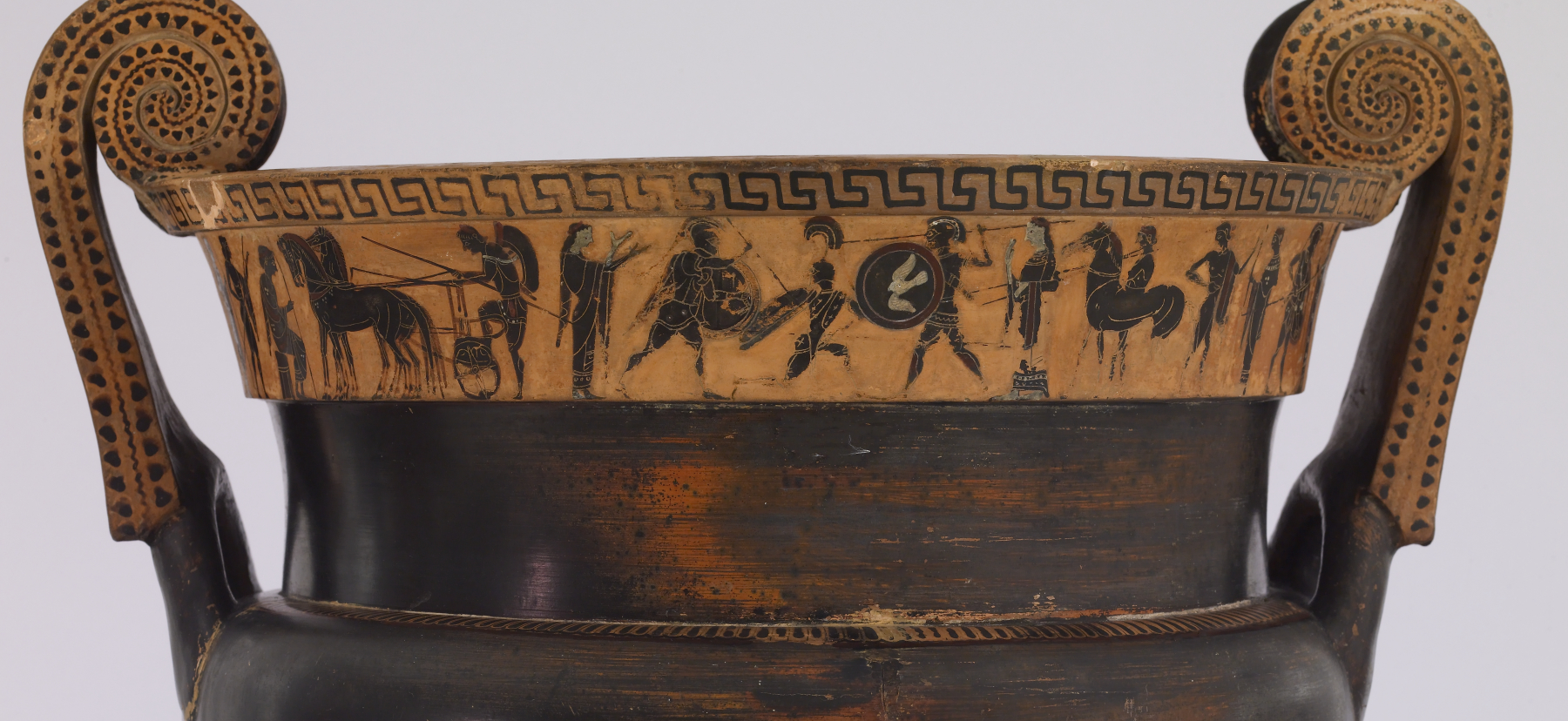Volute Krater Depicting Herakles, a Lion, Combat and Spectators
(Ancient Greece )
Beneath the meander-adorned rim of this large volute krater is a band of figural decoration interrupted by the handles on each side. At the center of the scene on one side is a trio of warriors, each wearing a short chiton and a full panoply of armor. The central figure lunges deeply to the right as he looks back at the soldier behind him. The figure on the left prepares to plunge his raised spear into the central warrior. The third soldier, on the right, also wields a spear in his upraised right hand, poised to strike. Flanking this central pair are two women in long, decorated garments. Each raises her hands, as if to address the men or express alarm. Behind the woman on the right is a horse and young man, perhaps a groom. Beyond them are four more figures, including a naked youth with a mantle, two men with staffs, and another fully armed warrior. To the left of the central scene, behind the woman, an armed warrior mounts a chariot, as if ready to flee from the fighting. A man seated in front of the horses interrupts the sense of motion evoked by the charioteer. The two figures behind the seated man resemble those at the other end of the scene: a naked youth wearing a mantle and holding a staff or spear and a standing man in longs robes with a staff.
Reminiscent of the central trio of warriors, three figures occupy the center of the scene on the opposite side, in a representation of Herakles wrestling the Nemean lion, with a youth, perhaps Iolaos, at hand offering support as he holds the hero's club. As with the composition on the other side, the figures are flanked by two female figures - a seated Athena on the right and a woman fleeing on the left. Further connecting the scenes is the depiction of charioteers mounting their chariots, which once again face seated men with staffs. A standing man with a staff frames the scene at either end.
Warriors figure prominently on both sides of this vase, which appears to celebrate the physical prowess of the central figures. The scenes highlight conduct in war and wrestling, two activities in which male citizens would have been trained and encouraged to emulate their heroic prototypes.
Provenance
Provenance (from the French provenir, 'to come from/forth') is the chronology of the ownership, custody, or location of a historical object. Learn more about provenance at the Walters.
[Excavated, "Foiano Tomb One" at Foiano della Chiana, Tuscany, 1879]; Alfonso del Soldato, 1879, by excavation. Don Marcello Massarenti Collection, Rome, before 1897 [mode of acquisition unknown] [cat. no. 209]; Henry Walters, Baltimore, 1902, by purchase; Walters Art Museum, 1931, by bequest.
Exhibitions
| 2009-2011 | Heroes: Mortals and Myths in Ancient Greece. The Walters Art Museum, Baltimore; Frist Center for the Visual Arts, Nashville; San Diego Museum Of Art, San Diego; Alexander S. Onassis Public Benefit Foundation (USA), New York. |
Conservation
| Date | Description | Narrative |
|---|---|---|
| 1/1/1936 | Treatment | cleaned |
| 1/1/1957 | Treatment | repaired |
| 8/26/1957 | Treatment | cleaned; repaired; loss compensation |
| 8/26/1957 | Treatment | repaired |
| 6/6/1972 | Treatment | cleaned; loss compensation |
| 7/27/1987 | Treatment | x-ray |
| 5/19/2000 | Examination | technical study |
| 2/19/2009 | Treatment | technical analysis; cleaned; stabilized; loss compensation; coated |
Geographies
Greece, Attica (Place of Origin)
Measurements
H: 23 1/16 x W: 20 1/2 x Diam: 16 15/16 in. (58.5 x 52 x 43 cm)
Credit Line
Acquired by Henry Walters with the Massarenti Collection, 1902
Location in Museum
Not on view
Accession Number
In libraries, galleries, museums, and archives, an accession number is a unique identifier assigned to each object in the collection.
In libraries, galleries, museums, and archives, an accession number is a unique identifier assigned to each object in the collection.
48.29








